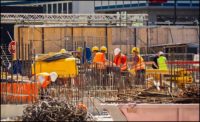The overall topic of resilience is a broad one with many facets of design and operation contributing to creating a more resilient building. One aspect of particular relevance to the building systems industry is energy usage, as was briefly mentioned in earlier columns. In this column, I’m going to take a deeper dive into how energy efficiency can enhance resilience and some of the ways in which design choices beyond the mechanical and electrical equipment can affect energy usage. Per the U.S. Department of Energy (DOE) report, “When a critical public facility needs less energy to function, it also needs less backup generation on-site to operate when the grid goes down.”
Of course, this applies to buildings other than critical government facilities. Any building that uses less energy day-to-day will also require less energy during a crisis.
The DOE report provides some case studies of how buildings accounted for energy needs during and after an event in the design and planning process. One case study investigated a medical center in Jackson, Mississippi. The facility installed a gas turbine CHP system and designed its systems so that they could be isolated from the grid, and the operators could reduce energy demand so that critical system operation could be maintained during an event.
A second case study examined a mixed-use building in Hartford, Connecticut. This project used a combination of energy efficiency, renewable energy, and resilience improvements, such as rooftop solar PV and a hydrogen fuel cell. In addition to being able to maintain service in the case of a disruption in the grid, the reduced energy demand resulted in a deceased energy cost of $300,000 in one year.
Additional examples look at the cost of maintaining sufficient on-site energy resources for various buildings considering baseline energy demands and a 20% reduction in demand. In all cases, the costs, including equipment and operation, were lower with reduced energy usage. But, how do we obtain better energy efficiency? One of the major variables that can affect energy demand is the structural system of the building itself. A study performed by CLEB Laboratories Inc. for the Insulting Concrete Forms (ICF) Manufacturers Association investigated the thermal performance of two wall types: ICF and traditional wood framed. The wood-framed wall used 2-by-6-inch members for the framing with 5 ½-inch batt insulation, vapor barriers, interior ½-inch gypsum board, and vinyl exterior siding. The ICF specimen used 6-inch ICF walls with 2 5/8-inch insulation on both sides, gypsum board, and vinyl siding. Both specimens were compliant with the then current building codes for energy. Note that the ICF wall did not require a vapor barrier to be added to the construction to meet air leakage requirements.
The results of the ASTM C1363-11 testing showed up to 60% annual energy savings for the ICF wall system as compared to conventional wood construction. Of course, other envelope features, such as windows, will reduce the total relative benefit, but there is no doubt that choosing a better performing wall will help to reach the kind of energy use reductions suggested in the DOE report. In addition to requiring less on-site energy to maintain service, ICF walls also have significant thermal mass, so when a power outage occurs, the walls will maintain their heat (or cool) for a longer time, further reducing energy needs to keep the building at the required temperature. Furthermore, ICF walls reduce damage to the structure and contents due to earthquakes and high wind and are fire resistant, all of which further adds to their resilience.
From the case studies, we see that reducing building energy demands can not only increase resilience to a loss of external power but also reduce the costs of providing sufficient on-site energy to ensure continued operation. As part of the effort to reduce energy consumption, the choice of the structural building material can play a significant role, particularly regarding the envelope selection. This is just one more reminder that, when designing for enhanced resilience, one must consider not only all aspects of the building design separately, but the impact of one system on another should be accounted for.





